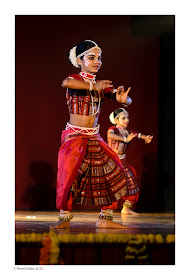Gotipua Dance
 |
| Geometric formations during the dance |
Odisha has a rich and diverse culture dating back to 3rd century. Land remained virtually isolated from the mainstream political turmoil for centuries was able to develop its own script, preserve temples for centuries and create various majestic dance forms.
Apart from well-known Odissi dance, Odisha has given numerous dance less known to the outside world. Most of the dance-form are developed from the rituals and practices carried out by over hundred tribes spread all over Odisha and neighboring states. The contents of which revolves around the god and goddesses worshiped by the people. Well known among them are Chaau Dance, Kanchi Abhijana, and Gotipua Dance.
 |
| Mudras by the dancer |
The word Goti Pua literally means Single boy. This dance is performed by young boys who dress up as female. The acrobatic figures practiced to praise Lord Jagannath or Lord Krishna.
Boys do not cut their hair and wove flowers while hair-dressing, to look natural like a girl. The face make-up includes Kajal (traditional black liner), Bindi (red dot on forehead) and patterns made on face with sandalwood paste. Traditional dress is called as Kanchula consisting a bright colored blouse and waist-wrap called Nibibandha. Jewelry is made with beads (a common unit for making jewelry among the local tribes). The costume, jewelry and the bells all are considered to be sacred items.
 |
| Dancers enters the stage. Accompanying musicians can be seen on the left |
Musical accompaniment is provided with
- Mardala (two heads drum, rhythm percussion instrument of Orissa)
- Gini (small cymbals)
- Harmonium
- Violine
- Bansuri or Baas (alto bamboo flute)
- and one or two vocalists.
 |
| Pose by the dancer during the performance depicting the trance during praising the lord |
It is largely from the Gotipua dance that the present form of Odissi dance has been inspired. Most of the present-day Gurus of Odisssi Dance (like the famous Guru Kelucharan Mohapatra from Raghurajpur village) were Gotipua in their young days [2].
There is strong reason why young boys at the age of five or six starts learning Gotipua dance. The flexibility of body at early age enables body to perform the various acrobatic figures and movements called as Bandha meaning acrobatic in Oriya. The difficult and intricate postures refer to mythological scenes from the life of lord Krishna.
 |
| Mayurbandh (peacock posture: sacred bird of the Hindu mythology, whose feathers were adorning the head of Krishna) |
Raghurajpur, an historic village near Puri, is famous for Goti pua dance.
 |
| Prof Sunil Sarangi, Director (NIT Rourkela), facilitating the troupe head |






Lovely that you had a chance to attend this.
ReplyDeleteSuperb pics, Paresh!
Our India has an amazing culture. Odisha has rich dance-forms that many are not aware of. Thanks for sharing the info :)
Wonderful pictures! Thanks for sharing ...
ReplyDeleteVery good website, thank you.
ReplyDeleteOdia Book Ketakibana
Order Odia Books
Odia Books Online